Modified classic 1973 BMW 2002 E10
When contributor, Rob Richardson, set out to build a period correct 2002 “cafe racer” we had to come along for the ride. Now ‘our’ project reaches a milestone – its full feature in BMW Car!
Words: Rob Richardson
Photography: Jamie Bufton
Our modified classic BMW project in all of its glory...
It is 1973, my name is Gert Hack and I live just outside of Oberstaufen. I work in an office as an engineer for a small family business but at weekends I enjoy motor racing, mainly hill climbing. We have some great bergrennen events around here; the local town is taken over with race cars from all around who run up a closed road circuit. I’m not competitive, I only join in for the thrill of racing. I use my everyday car, a BMW 2002 I bought only last year. It is a fantastic and stylish family car, but also has great sporting credentials; it “goes like schnell”. My Friend Jurgen works at Alpina in Buchloe and supplies me with tuning parts for the car, helping me to improve its performance for my weekend racing”.
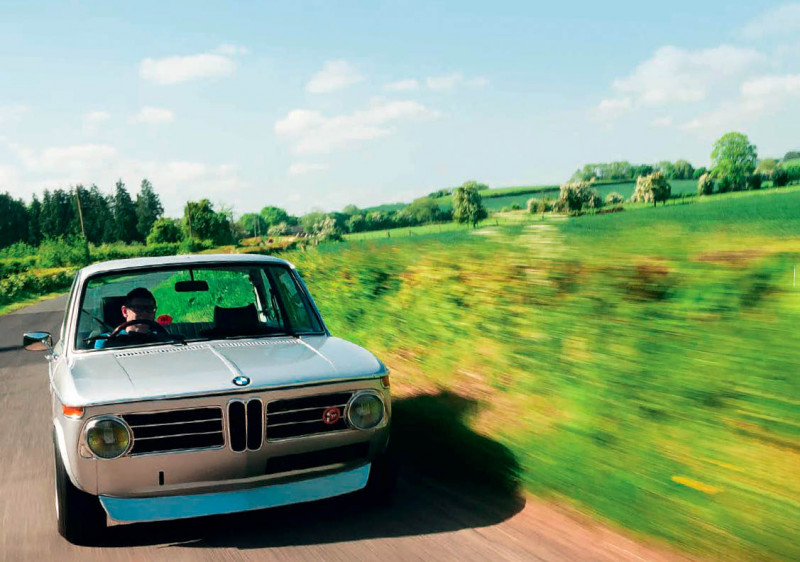
What happens when a car build becomes more than a car build? It becomes live action role play. I am with Gert as my muse, reliving the early ‘70s. I’ve always known how I wanted my 2002 to look and feel having wanted to own one for years. With Gert and a rich seam of tuning and racing history as my guiding inspiration, it couldn’t, to me, have come together more perfectly: a period correct “café racer” with a ‘race on Sunday, pick the kids up on Monday’ feel. Every decision on the car has been made with a Chapman-esq obsession – removing weight and adding simplicity, as well as a little Porsche RS OEM execution, a nod back to my previous 911 build. This car’s first race wasn’t up a closed road in Obserstaufen though, it was a race to get it into my garage.
It feels alive and connected to the road – it makes energetic progress
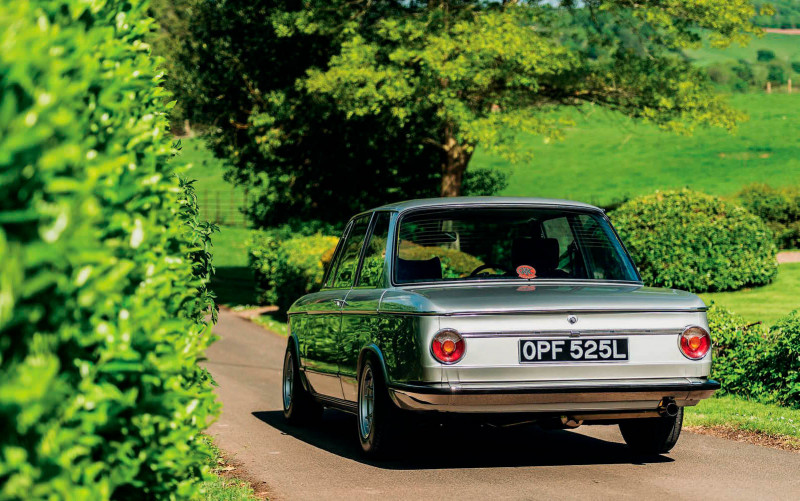
The hunt for the car started in May 2019.
Having wanted one for a long time I decided it was now or never and sold my 1978 911. So, now I had a space to fill in the garage and the cash burning a hole in my pocket, the race was on: my wife was due with our first child in June. The usual internet trawling ensued to find the right car: it had to be a 2002, not a Tii (I didn’t want fuel injection), an early “roundie” and no sunroof. I didn’t want to do any rust repairs or bodywork either; I wanted a mint shell. This car didn’t exist. At the time I was looking there wasn’t a single 2002 for sale in the UK I could find. There were some in the Netherlands and I was even bidding on one in California on “Bring a Trailer” that had been built by DV Mechanics, but it wasn’t to be as the hammer fell on a number out of reach as I had to consider shipping as well. It was time to give up, focus on impending parenthood and… I’ll just send one more email: “Good morning, this might be a bit outside your remit, but I thought it was worth an ask…” The email in question was sent to Retro Engineering, a family business specialising in historic touring car preparation on BMWs from the ‘60s, ‘70s and ‘80s. It also happened to be a stone’s throw from my house. Just two hours later I got a response “…a friend of mine is selling a silver, round light 2002…” The next day I paid Nigel and the team a visit to talk more and see their premises.
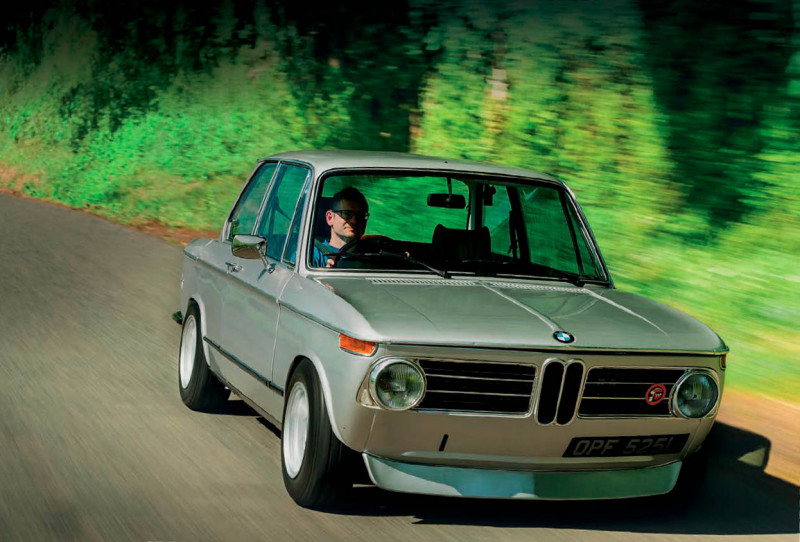
And what a place it was: incredible engines and cars beautifully built, set in a unit with walls filled with racing nostalgia. After a fantastic chat with Nigel and the team he told me about the car in question which belonged to a customer, an ex-BMW master technician, which had been rebuilt and was for sale. He arranged for the car to be brought to Retro Engineering HQ for me to view a few days later and, with my wife at home now overdue, I raced out to see it with my phone at my side and set to ‘loud’ just in case. The car was fantastic; the exact specification and year I wanted and in sympathetically restored condition with plenty of character and careworn patina retained. A test drive sealed the deal and a bank transfer made it mine. The next day the car arrived on my drive. It was quickly parked in the garage as not much over 24-hours later my wife went into labour… I’d managed to buy the dream car, just in time. It sat in the garage for a few weeks before I could even really look at it as I adjusted to my new life as a parent. The car came with a very limited back story. It had been in storage for 11-years and had been bought by the previous owner as a “pension pot project”. As an ex- BMW master technician he was well placed to gather up the boxes of 2002 and complete the jigsaw which included an engine rebuild.
It had come so far that it was time to make it perfect...
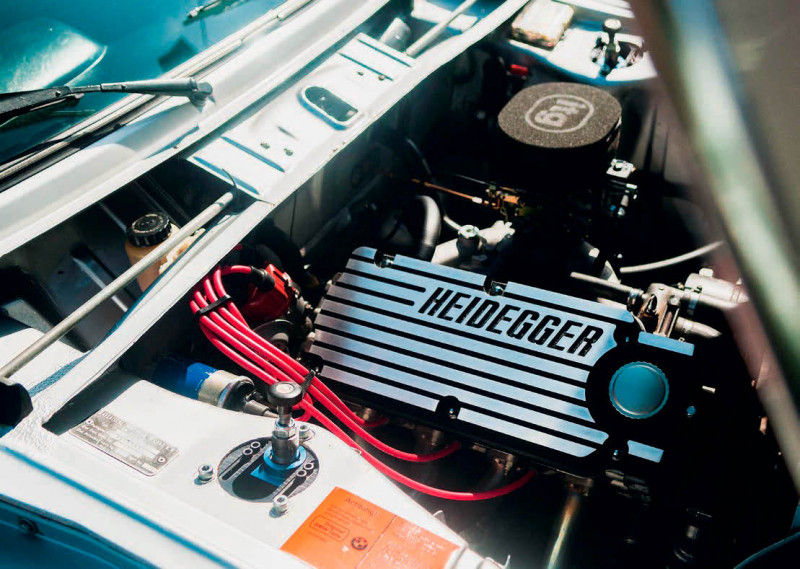
The car was completely standard, and while rock solid and rust free, needed a bit more love cosmetically than my initial rose-tints had seen, but this was limited to some storage damage down the right hand side. In a bid to learn a little more I contacted the UK 2002 register about the car but there no records, I had it added so it exists officially now. And that was all I knew, a car with no real story despite fifty years of existence. This made it even more compelling to give it one.
With the brief already set – to build a café racer style period 2002, I started collecting the best parts while on paternity leave. Sleepless nights give you plenty of opportunity for research and shopping. For the first summer on the road I wanted to keep it simple to maximise my time actually driving and getting to know the car: suspension, wheels, front bumper off and a major service and tune up. Bilsteins were sourced through Retro Engineering along with camber adjustable top mounts while an amazing set of refurbished Ronal Kleeblatt wheels came via Old Timer Wheels. Getting it running right was the hard part thanks to the original Solex carb, despite several rebuilds and new jets, it refused to play ball. I spluttered through the first summer with limited use, carried by the warm honeymoon period glow of finally owning an E10. But as winter came, it was time to get serious. This “not a restoration” had become a restoration.

Winter 2020/2021 saw the car go up on axle stands for a complete overhaul. Every nut and bolt was turned. First up was dealing with the running issues: a new 32/36 Weber DGV kit from Webcon and a completely new ignition system from rotor arm to plugs was installed. Focus now moved to the extraction side of combustion: the exhaust sound and system is such a huge part of the experience of a car for me so it had to be right. A Fritz’s Bits manifold and Supersprint exhaust were fitted giving both the aural experience I wanted and the stainless sculpture the engine bay needed. Next was the fuel pump.
Having switched to a mechanical M30 pump previously, I eventually gave in, betraying my analogue morals, and fitted a Facet electric pump for easy starting. It also cleaned the engine bay up with a neat blanking plate on the head. As the car had been standing so long I opted to completely rebuild the cooling system from a new thermostat to a new water pump, re-cored uprated radiator and a thermostatically controlled Spal fan. This was so powerful I could delete the engine mounted fan and free up all the M10 had to give, while ensuring the needle would never deviate from the halfway point. The other side of that was also ensuring the wiring behind the needle was correct; an additional earthing harness was built for the cluster to overcome the common “bouncing gauges” and while the soldering iron and crimpers were out I went through the harness top-to-bottom to make sure it was not only fully functional, but as simple as possible.
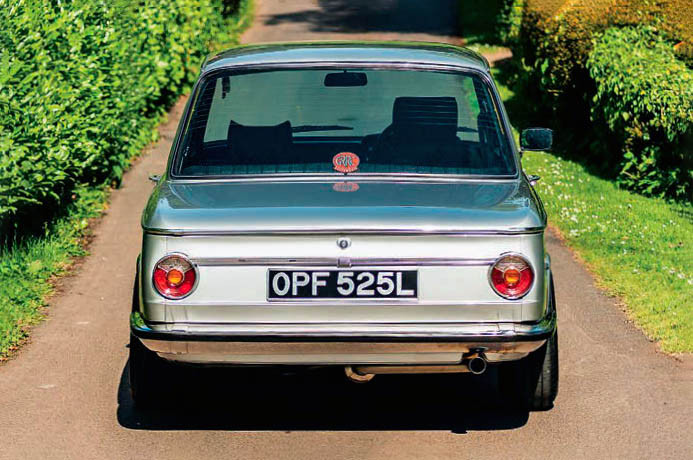
With the running sorted I revisited suspension and wheels. The Bilsteins were good, but stiff and the car was too high for my taste. The Kleeblats looked the part, but the car lacked the dramatic, muscular stance that I think is so important. I wanted it to look fresh off the Goodwood Members’ Meeting grid or, more to the brief, the paddock of a German hillclimb round in 1973. I re-bushed the entire car nose-to-tail with Powerflex Heritage bushings. Not only are these uprated from standard and will last forever, they make the rear beam toe and camber adjustable giving me, in combination with the front camber plates, complete adjustability in the suspension. The Bilsteins were sold and I got in touch with Gaz Shocks for a new set-up. Gaz offered a 2002 kit, we discussed my requirements and I took delivery of a set of its rear coilover units with the front legs converted to coilover in “fast road” (read “not horrible to use on the road”) specification. These gave me damping and height adjustment so I could dial the car in exactly how I wanted it. Crucially these were built to run low, so I have good ride even at this height. The cherry on the cake was a set of Maxilite CD66 Cromodora recreations in 7x13-inches. These required a huge amount of work on the wheel arches to fit without rubbing and even slight compromises to final geometry were required to get them under the narrow-body car, but it was absolutely worth it. The simple Bauhaus restraint of the body means the car suits a detailed wheel and with their deep, concave faces, they make the car. Chunky Blockley tyres with a period racing tread pattern seal the deal, extended studs – aiding pit-stop quick wheel changes – hold them on.
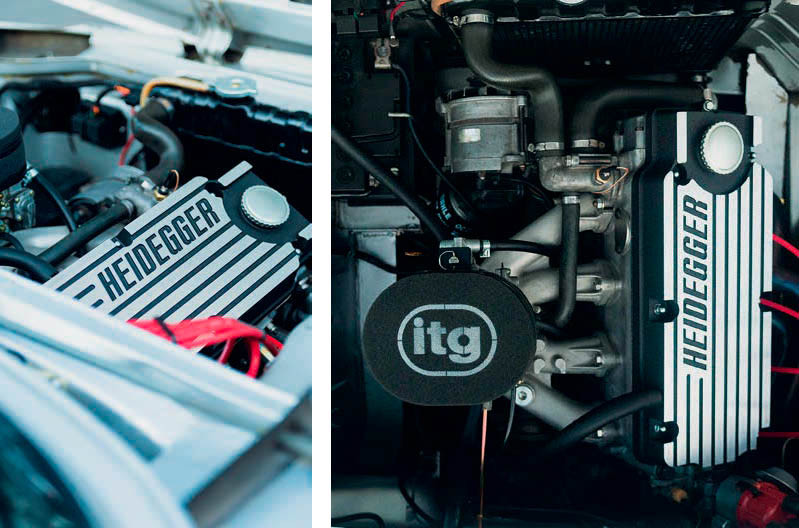
The last area to revisit was the brakes. The car came to me with desirable vented Tii brakes and braided lines on, but they never performed as you’d expect. Clearly the whole system was a casualty of being left to stand. The rear wheel cylinders had perished and were leaking and a hunting idle pointed to vacuum leaks at the servo. The rears were a simple fix with new, Tii wheel cylinders fitted and a fresh set of drums, but the servo issue led to the biggest project on the car. I could have opted to have them rebuilt but took the opportunity to take some weight out and simplify a very complex system. The car, having been engineered for left-hand drive, had a huge number of pipes to and from the servos on the left-hand side, as well as the twin servos themselves and associated pipework – it was a lot of stuff and it looked messy. With it all stripped out of the car I remade the pipes and plumbed in an adjustable pressure regulator valve for the rear brakes allowing me to tailor the brake balance.
To offset the lack of assistance I modified the pedal box to increase the pedal ratio; the result was over 10kgs weight reduction and a much cleaner engine ‘bay, and most importantly, a solid, progressive pedal – full of feel and easy to modulate. Completing the package, EBC Yellow pads now grip the discs making the car road and track ready.
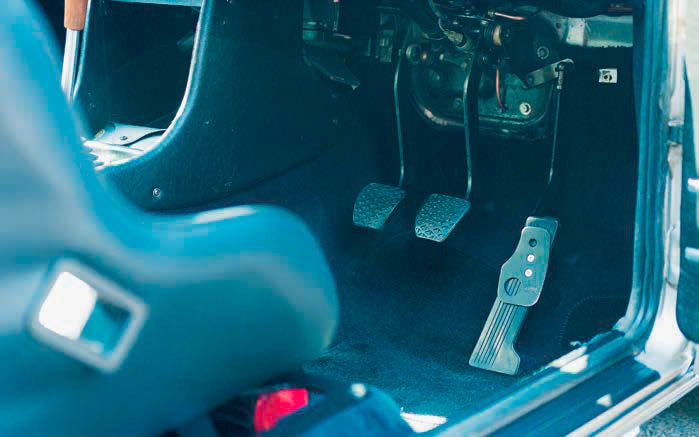
Moving to the interior I stuck to my ‘weekend racer’ mantra and kept the full interior bar some key additions. The interior was in lovely condition with a perfect dash and re-trimmed seats as delivered so there was no work to do here. What I did want to add was a period ‘racing’ driver’s seat. A Cobra RSR was chosen and the team matched the OEM basket weave finish to perfection. I mounted it on a bespoke subframe, CAD modelled and laser cut from steel, to my exact seating position. Removing the runners saved weight and simplified the system (there’s a theme here) allowing me to get the seat as low as possible for that race car feel. Every interaction with the car is key to the experience and there are none more important visually and physically than the steering wheel. Out went the beautiful, but bus-sized factory wheel for a lovely MOMO GP which matched the OEM gear knob. This also brought much needed weight to the steering and contrast to the otherwise black interior. Once lowered into the seat and behind the wheel the next thing you reach for is the gear stick; a slack factory change wasn’t an option so I replaced the shifter with an AKG motorsport billet short shifter. So precise is this shifter they won’t sell you one without also buying Group N engine and transmissions mounts, so these were fitted as well. Snicking through the four-speed ‘box is a firm, mechanical affair and not to be rushed. Well-oiled and precise, every shift is a joy and another reminder you’re operating machinery that requires your attention. It’s part of the escape. The final detail is a Heuer Trackmaster stopwatch on the dash; as Gert lines up, dips the clutch, threads the gate into first and holds the revs up to launch, he can hit the start button as the flag drops and race the clock in real-time.
When the car arrived, I was adamant that I didn’t want to get into paint and bodywork, but it had come so far that it was time to make it perfect. Over the winter of 2021/2022 I dropped the car with my painter, Simon Wright, with a brief to retain as much of the original paint as possible and match the look of the rest of the car. While in paint I also added the front splitter completing the race shark’s face. The paint was kept to the right-hand side and cleaned up all the storage damage. The rest was then detailed and I added a new custom Harrington stainless steel rear bumper. The final few custom touches were speed holes in the wing mirror, yellow headlight bulbs, a unique rear numberplate light and, in a nod to 911R and RS Porsche, I replaced the bonnet badge with a decal. The final flourish, and period holy grail part, is the Heidegger valve cover. Not a real one, but a beautifully engineered one by Tim Jason Performance who CNC machined it from a single billet of aircraft grade aluminium. I like to think Gert could have bought one from a fellow racer in the pits, or while on holiday in Triesen visiting Heidegger themselves.
In a seemingly endlessly and digitally connected world the significance of classic car ownership for me has gone from simply “they are beautiful things and I can fix them myself” to a complete analogue indulgence I can’t find anywhere else. The E10 chassis is an incredible piece of engineering and as I’ve gone through and modified and upgraded the car, I’ve sought to keep true to its roots and only enhance, rather than change it’s character. It’s a lighter, purer, faster version of the car that came to me three-years ago and is an absolute pleasure to drive. Key to this has been retaining its road-car manners and usability but giving it the dynamic capability and aural soundtrack to bring pure motoring joy on my favourite road, or on a trip to the shops. It’s more than the sum of its parts in this respect and despite a modest 110hp, its light kerb weight (900kgs) means it feels alive and connected to the road – it makes energetic progress, with enough time to enjoy every gear change and race to the red-line. Clicking through a DCT this is not, and it’s all the better for it.
This feature represents a huge milestone in the project, but it’s not finished, these things never are. Those of you that have come with me on this build, following my progress monthly in “Our Cars”, will be pleased to know there’s still more to come. As we go to press a set of 40 DCOE Webers are on the way, an irresistible addition to an M10 and will also future proof the engine for further performance down the line.
This car came to me without a real story, so I’ve written one for it and become part of it myself. Now it’s come this far I plan on driving and enjoying it as much as I can, just call me Gert.
THANKS
My wife Lucy for her constant support and thanks also to No1, Rory, who hung on until I got the car in the garage. All the people who I’ve worked with and have supported project: Retro Engineering, Webcon, Gaz, Cobra, Lakeside Service Center, Powerflex, TJP, EBC, AKG, Maxilite, Spal, Classic Engine Workshop, Jaymic, Simon Wright Paint.
TECHNICAL DATAModified classic 1973 BMW 2002 E10
- ENGINE & TRANSMISSION: 2.0 M10 32/36 Weber DGV, ITG filter, Fritz’s Bits manifold, Supersprint exhaust, SPAL fan, Facet fuel pump, TJP Heidegger valve cover, 4-speed, AKG short shifter and powertrain mounts.
- CHASSIS: Gaz coilovers, camber pillow ball top mounts Powerflex heritage bushes, Tii brakes, EBC Yellow pads, bias valve, servo delete, 7x13” Maxilite CD66 alloy wheels
- EXTERIOR: Polaris Metallic Silver, front bumper delete, Harrington rear bumper, GRP splitter, modified arches
- INTERIOR: Cobra RSR driver’s seat, Momo GP steering wheel, Heuer Trackmaster stopwatch


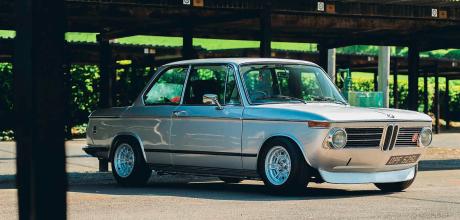
2002 Project I really enjoyed the feature on the 2002. I have followed the project in BMW Car from the start and eagerly anticipated each new instalment to see how it was going to develop. So often these days modified classic cars seem to lack a plan or any kind of thought in their execution, things get thrown together without consideration for the final look and feel, or how the thing will drive. Rob Richardson’s car seems to have been well thought through and exceptionally well engineered – well done Rob! I think Rob’s car might well be one of the best ‘02s in the country, if not the world, and I’m looking forward to seeing where the project goes next.